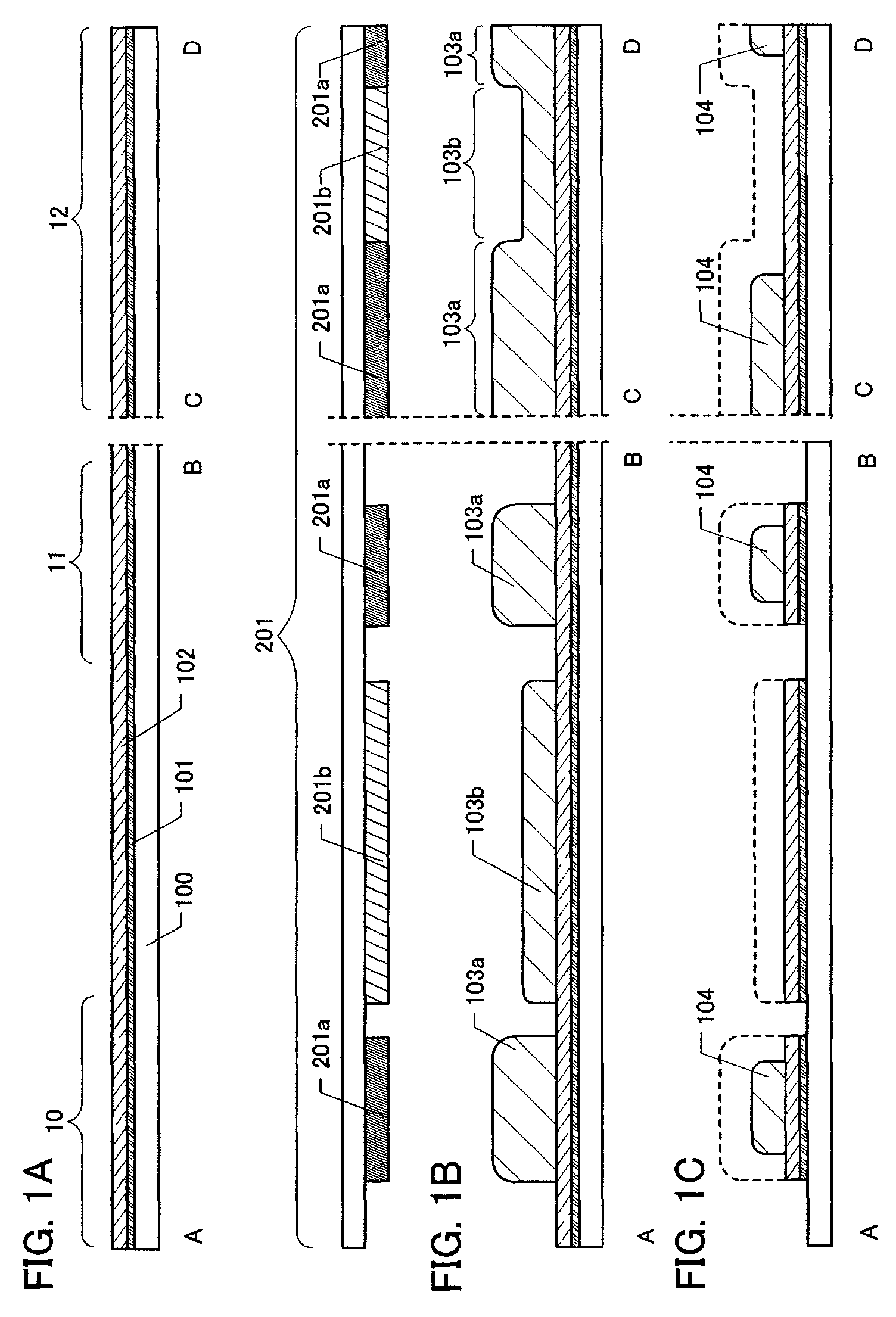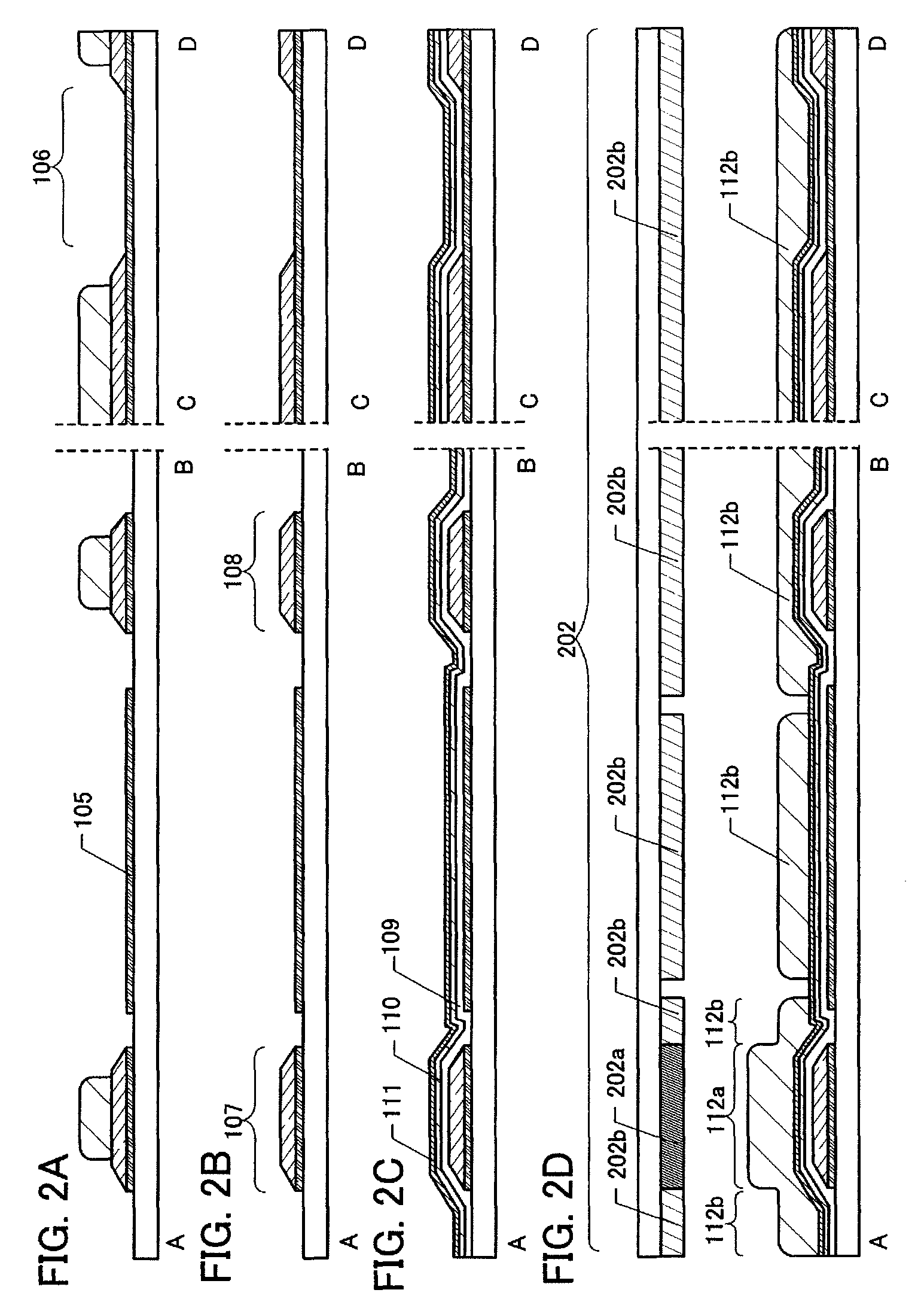Method for manufacturing an LCD device employing a reduced number of photomasks
a technology of lcd device and photomask, which is applied in the field of display devices, can solve the problems of reducing the yield of misalignment between photomasks, requiring a large amount of cost and time to conduct one photolithography process, and reducing the number of photomask alignments, so as to reduce the number of photomasks , the effect of suppressing the reduction of the yield caused by misalignment with another photomask
- Summary
- Abstract
- Description
- Claims
- Application Information
AI Technical Summary
Benefits of technology
Problems solved by technology
Method used
Image
Examples
embodiment mode 1
[0036]Description is made using a liquid crystal display device which is one mode of display modes. FIG. 11 is a plan view illustrating a TFT substrate of the liquid crystal display device according to Embodiment Mode 1. A region divided by scan lines 1101 and signal lines 1102 is one pixel, and a region in which a pixel electrode is formed in a pixel is referred to as a pixel region. A TFT 1103 which is a switching element of a pixel is in lower left portion in pixel. An on / off signal of TFT is input from the scan lines 1101 and a video signal is input from the signal lines 1102. The TFT 1103 is electrically connected to a pixel electrode 105 through a contact hole 113a, and the video signal input from the signal line is transmitted to the pixel electrode through the TFT when the TFT is in an on state. A storage capacitor 1104 is formed in upper right portion in pixel. The storage capacitor 1104 has a function that stores the video signal input into the pixel electrode 105 until su...
embodiment mode 2
[0066]Then, in FIGS. 6A to 6C and 7A and 7B, a process using three photomasks of the present invention is described. In this process, the steps to the step for forming a source electrode and a drain electrode are similar to the process using four photomasks which is illustrated in FIGS. 1A to 1C, FIGS. 2A to 2D, FIGS. 3A to 3C, and FIGS. 4A to 4C of Embodiment Mode 1; therefore, the description thereof is omitted.
[0067]In FIG. 6A, the protective insulating film 123 formed of a silicon nitride film or the like is formed over the entire surface of the substrate by a CVD method. Then, a photoresist 601 is formed over a portion in which the first conductive layer and the second conductive layer are present by exposing process from the back surface of the substrate by backside light exposure. Here, since portions in which the transparent conductive film is formed of a single layer and which are not covered with electrodes formed of the second conductive layer transmit light, it is import...
embodiment mode 3
[0073]A process using three photomasks of a top gate type TFT using the present invention is described. FIG. 12 is a plan view illustrating a TFT substrate of a liquid crystal display device according to Embodiment Mode 3. A region divided by scan lines 1201 and signal lines 1202 is one pixel. A TFT 1203 which is a switching element of a pixel is in lower left portion in pixel. An on / off signal of TFT is input from the scan lines 1201 and a video signal is input from the signal lines 1202. The TFT is electrically connected to a pixel electrode 811, and the video signal input from the signal line is transmitted to the pixel electrode through the TFT when the TFT is in an on state. A storage capacitor 1204 is formed in upper right portion in pixel. The storage capacitor 1204 has a function that stores the video signal input into the pixel electrode 811 until subsequent signal is input. In FIG. 12, a portion shown by a dotted line A-B corresponds to cross-sectional views of FIGS. 8A to...
PUM
 Login to View More
Login to View More Abstract
Description
Claims
Application Information
 Login to View More
Login to View More - R&D
- Intellectual Property
- Life Sciences
- Materials
- Tech Scout
- Unparalleled Data Quality
- Higher Quality Content
- 60% Fewer Hallucinations
Browse by: Latest US Patents, China's latest patents, Technical Efficacy Thesaurus, Application Domain, Technology Topic, Popular Technical Reports.
© 2025 PatSnap. All rights reserved.Legal|Privacy policy|Modern Slavery Act Transparency Statement|Sitemap|About US| Contact US: help@patsnap.com



